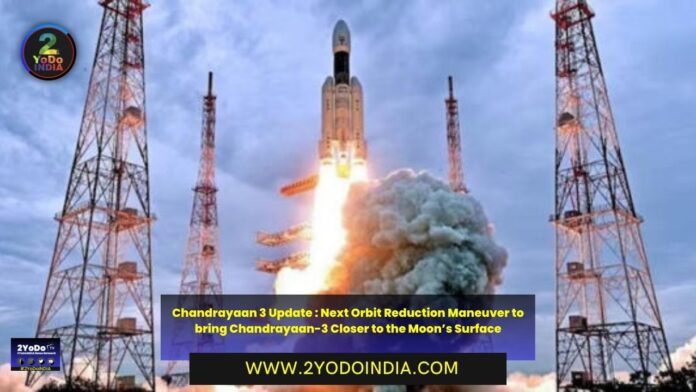The next orbit reduction maneuver to bring India’s ambitious Chandrayaan-3 spacecraft closer to the Moon’s surface is schedule on 14th August 2023 between 11:30 am and 12:30 pm.
Before, the Indian Space Research Organisation’s (ISRO) latest mission to Moon move closer to the Moon’s surface on 9th August 2023.
After the orbit reduction maneuver, Chandrayaan-3’s orbit was reduce to 174 km x 1,437 km.
After its launch on 14th July 2023, Chandrayaan-3 enter into the lunar orbit on 5th August 2023.
Since its entry into the lunar orbit, the Chandrayaan-3 spacecraft has been engage in a series of orbit maneuvers.
The lunar mission aims to execute a soft landing on the moon’s surface on 23rd August 2023, according to ISRO chairman S Somanath.
S Somanath also said that de-orbiting maneuvers will be perform on 9th August 2023, 14th August and 16th August till the orbit reduces to 100×100 km from the Moon.
If Chandrayaan-3 is able to make a smooth landing on the Moon’s surface, India will become the fourth country in the world to achieve the no-mean feat.
India will join the likes of the US, Russia, and China.
Chandrayaan-3’s landing on the Moon could be a challenge due to the Lunar South Pole’s rugged terrain having huge craters, dark lightning conditions during descent even with advanced sensors.
Chandrayaan-3 is a follow-on mission to the Chandrayaan-2 aim at demonstrating end-to-end capability in safe landing and roving on the lunar surface.
Chandrayaan-2 was launch from the second launch pad at Andhra Pradesh’s Satish Dhawan Space Centre in July 2019.
This mission could not be accomplish as the lander crash since it deviated from its intended trajectory while attempting to land on 6th September, 2019.
The Chandrayaan-3 spacecraft comprises an indigenous propulsion mode, a lander module, and a rover to demonstrate vital technologies for inter-planetary missions.
The propulsion module will carry lander and rover until 100 kms of lunar orbit, which features a Spectro-polarimetry of Habitable Planet Earth (SHAPE) payload for earth observations.
The lander is equip to land at a designate location and deploy the rover for chemical analysis of the lunar surface.
The rover named ‘Pragyan‘ will have three payloads, the Laser Induce Breakdown Spectroscope (LIBS), the Alpha Particle X-Ray Spectrometer (APXS), and Spectro-polarimetry of Habitable Planet Earth (SHAPE).
The Laser Induce Breakdown Spectroscope (LIBS) will determine the elemental composition of lunar soil and rocks around the lunar landing site.
The Alpha Particle X-Ray Spectrometer (APXS) payload will derive the chemical composition and infer mineralogical composition to further enhance our understanding of the lunar surface.
Spectro-polarimetry of Habitable Planet Earth (SHAPE) is an experimental payload in Pragyan to study the spectro-polarimetric signature of the habitable planet Earth in the near-infrared (NIR) wavelength range.
The lander has four payloads, Chandra’s Surface Thermo Physical Experiment (ChaSTE), Instrument for Lunar Seismic Activity (ILSA), Langmuir Probe (LP) and Laser Retroreflector Array from NASA.
Chandra’s Surface Thermo Physical Experiment (ChaSTE) will measure the thermal properties of lunar surface near the polar region.
Instrument for Lunar Seismic Activity (ILSA) will measure the seismicity around the landing site whereas the Langmuir Probe will estimate the plasma density and its variations over time.
A passive Laser Retroflector Array from NASA is use for lunar laser ranging studies.
ISRO has three objectives with the Chandrayaan-3 mission, getting a lander to land safely and softly on the Moon’s surface, observing and demonstrating the rover’s loitering capabilities on the Moon and in-site observation and carrying out experiments on materials available on lunar surface to understand the Moon’s composition.





